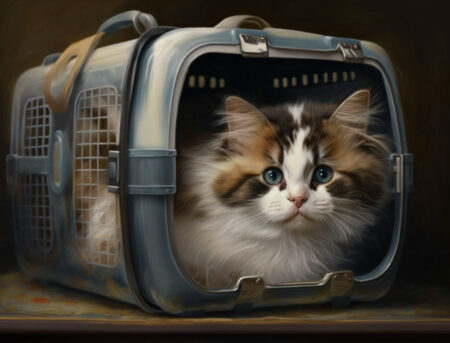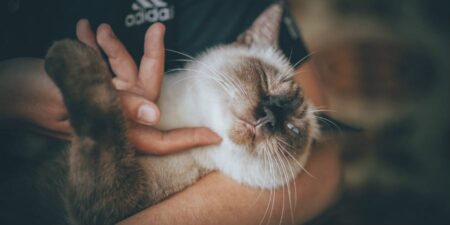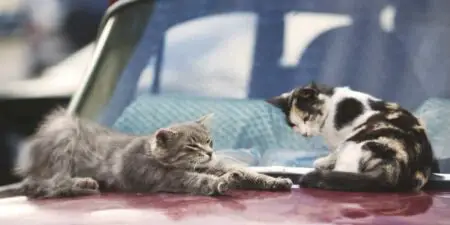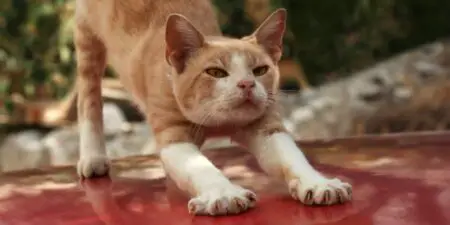So you’re curious about whether using punishment is ever the way to go when training cats, or if sticking with positive reinforcement techniques is always better.
This has been a pretty hot topic lately among cat owners, and honestly, the approach we take really impacts our relationship with our feline friends.
Let’s dig in.
Punishment vs. Positive Reinforcement
When it comes to training cats, punishment typically means applying some sort of negative consequence right after an unwanted behavior in order to reduce its occurrence.
People might be tempted to use this method because they think it’ll deliver quick results or perhaps they’re just following old-school advice that doesn’t prioritize the cat’s well-being.
On the flip side, positive reinforcement emphasizes rewarding good behaviors while ignoring bad ones so that over time, your cat learns which actions are encouraged.
6 Common Punishments to Avoid
Some examples of unencouraged punishment people may apply to cats include:
- Yelling or shouting – Raised voices are directed at the cat when it exhibits undesirable behavior, which only seems to scare the cat and make it fearful.
- Water spraying – Squirting water from a spray bottle at the cat when it’s engaging in unwanted activities like scratching furniture or jumping on countertops.
- Physical punishment – Hitting, tapping their nose, or swatting at the cat as a form of discipline for displaying bad behavior.
- Rubbing their nose in messes – Forcing a cat’s face into its urine or fecal mess (like eliminating outside the litter box) in an attempt to teach them not to repeat this action.
- Scolding or scaring – Using loud noises such as shaking coins in a can or noisemakers so they feel startled when they misbehave.
- Timeouts – Isolating a cat after undesired behavior by confining them to another room for some time (keep in mind that cats do not interpret timeouts well and would usually feel confused).
Using these punishments may damage your relationship with your cat and are almost always counterproductive; in my opinion, positive reinforcement should be used instead.
Putting Your Cat in a Carrier as Punishment

Putting a cat in a carrier as punishment isn’t recommended and can be counterproductive.
There are several reasons why using the carrier as punishment is an unfavorable approach:
- Negative association – If the carrier is used for punishment, your cat may come to associate it with fear, stress, or anxiety. This negative association can make routine events like vet visits or travel even more difficult and distressing for both you and your cat.
- Ineffective communication – Cats don’t easily understand the connection between their undesirable behavior and being put in the carrier as a consequence. They may become confused about why they are confined rather than learning from their mistake.
- Damaged trust – Using carriers as a form of punishment could undermine your relationship with your feline companion by fostering resentment or damaging their trust in you over time—potentially leading to avoidance behaviors that hamper bonding experiences sustainably.
Instead of using the carrier for punishment purposes, rely on positive reinforcement techniques aimed at guiding cats toward desired habits
Emphasize reward-based methods that foster mental growth while cementing healthier bonds built on mutual respect between owners and pets alike.
Why Punishment Is Wrong
There are some real downsides to punishing your cat during training.
First off, punishment can strain your relationship by fostering fear and mistrust between you two – definitely not what we want!
Also, it’s important to remember that cats don’t always associate punishments with their actual bad behavior; instead, they might end up being confused or develop anxiety.
On a more practical note: research suggests pretty strongly that positive reinforcement is simply more effective for long-term behavioral change because it promotes consistent learning experiences for our furry friends!
While punishment might seem like an easy option initially for “fixing” a problem quickly (although not guaranteed), choosing only positive reinforcement yields both better relationships and results in raising well-behaved kitties who trust us – totally worth considering!
Why Positive Reinforcement Is Always a Better Alternative

So now that we’ve established the potential drawbacks of using punishment in cat training, let’s dive a bit deeper into what makes positive reinforcement such an appealing alternative.
Positive reinforcement isn’t just for cats, it has also been shown to be effective in training dogs and other species as well.
When used properly, this method taps into the natural instincts of cats to seek rewards by associating good behavior with positive experiences.
6 Positive Reinforcement Techniques
1. Treats – Provide your cat with a tasty morsel or their favorite snack when they perform the desired behavior, such as using the scratching post instead of the furniture.
2. Praise and attention – Verbal praise or petting your cat can reinforce good behaviors, like sitting calmly rather than jumping on you while eating.
3. Toys – Rewarding your cat with a fun toy after sitting still during grooming sessions, for example, will increase the likelihood that they maintain their calm demeanor in future sessions.
4. Playtime – Offering interactive playtime as a consequence of completing certain tasks or performing desired tricks makes learning more enjoyable and serves as a motivating factor for cats.
5. Training clickers – The use of clicker training—a device that emits an audible clicking sound—allows you to mark the precise moment when your cat performs well during training followed by an immediate treat reward.
6. Food puzzles and feeders – Food-dispensing toys can be used to reward cats for finishing playful activities or solving intriguing problems that stimulate their cognitive abilities effectively; these clever devices inject mealtime with fun and engagement while encouraging good behavior patterns all at once!
The key is consistency – always present rewards immediately following good behavior – to ensure a clear association between performing specific actions and receiving relevant positive consequences; this method strengthens desirable habits over time while making learning sessions an enjoyable bonding experience.
Additionally, it can strengthen your bond because your kitty will associate you with pleasant experiences.
Another bonus of using positive reinforcement is that it encourages your cat’s mental growth and development.
6 Ways Positive Reinforcement Encourages Your Cat’s Mental Growth and Development

1. Stimulates cognitive abilities – During training, using positive reinforcement requires the cat to think, process information, and make decisions. This intellectual engagement helps sharpen their cognitive abilities.
2. Builds confidence – As cats learn to associate certain actions with rewards, they become more confident in performing those behaviors. Over time, this builds their self-assurance and promotes emotional well-being.
3. Encourages new skills – By rewarding desired behaviors with praise or treats consistently, you’re motivating your cat to try new things and embrace learning different commands or tricks rather than avoiding them due to fear of punishment.
4. Fosters problem-solving skills – When confronted with challenges or puzzles (e.g., puzzle feeders), reward-based training techniques encourage cats to brainstorm solutions creatively—supporting their ability to tackle future situations independently.
5. Enhances communication skills – Positive reinforcement strengthens the bond between you and your cat by promoting effective communication that’s rooted in understanding each other’s signals (verbal/non-verbal) clearly without any fear or anxiety getting in the way.
6. Provides mental stimulation – Engaging your cat positively during play sessions or outdoor exploration stimulates mental activity by exposing them to new experiences while providing an opportunity for learning through non-threatening guidance and rewards-based feedback when attempting unfamiliar activities.
Overall, positive reinforcement plays a crucial role in optimizing feline brain health – facilitating learning capabilities while sharpening concentration span throughout training sessions – all wrapped within a nurturing environment that fosters long-lasting trust between owners and their four-legged companions.
Summary
So there we have it – opting for positive reinforcement over punishment not only wins out from an effectiveness standpoint but also fosters trust and strengthens bonds between kitty companions and humans.
It may take more patience than punishment-based methods initially; however, your hard work will pay off when you develop a lasting trust with your furball while curbing unwanted behavior too.
Guide to Help with Naughty Cat Behavior (Video)
"In ancient times cats were worshipped as gods; they have not forgotten this."
-- Terry Pratchett





